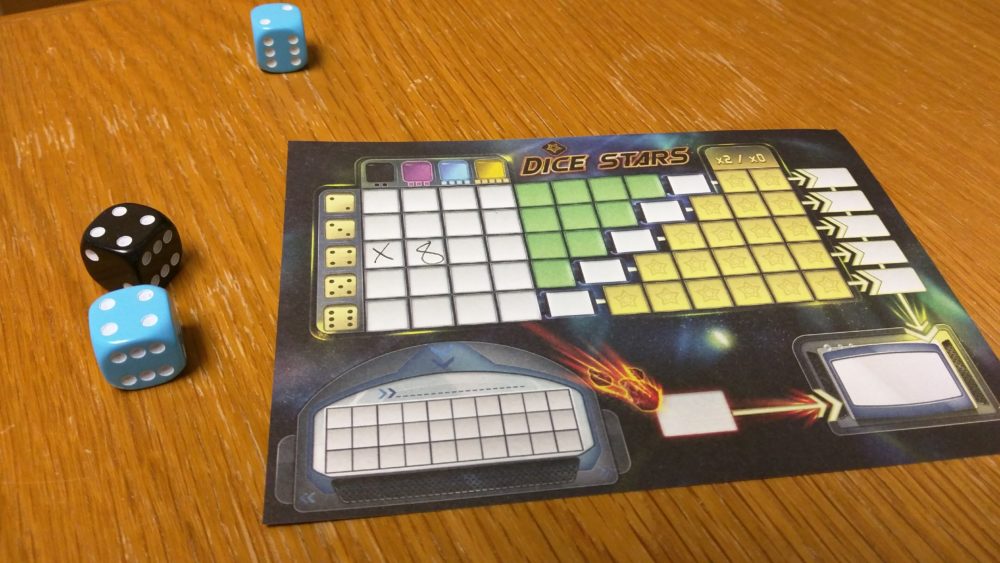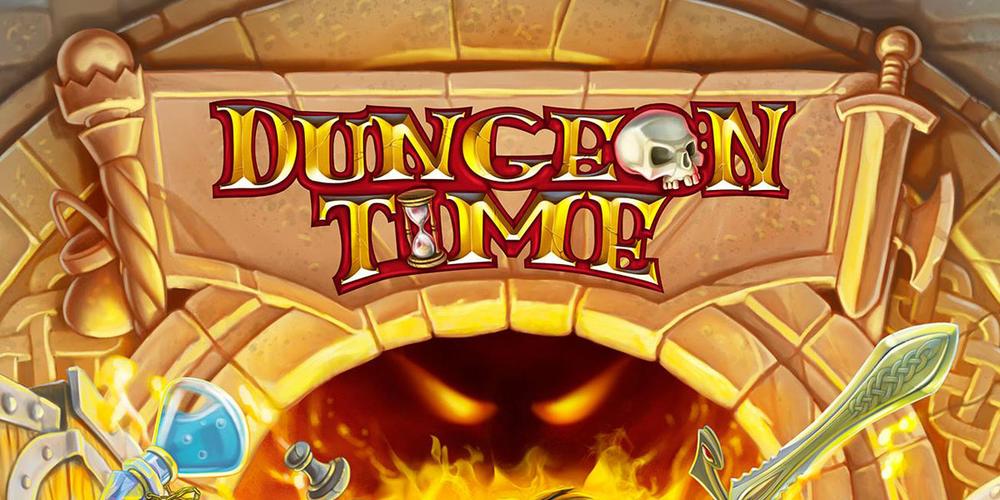
I love dice—so much so, in fact, that I had a D20 tattooed onto my bicep. I just like to have dice around, you know? I love the way they look, the feel of their precise edges, and the unmistakable sound they make as they tumble across a tabletop.
Unsurprisingly, this is what initially drew me to WizKid’s Dice Stars, a new game by Bruno Cathala and Ludovic Maublanc. Dice Stars, you see, is all about the dice.
At a Glance
Dice Stars is an easy-to-learn tabletop dice game for 1-4 players ages 10 and up. A standard game takes around 20-30 minutes from the first roll to the final score tabulation. It retails for $19.99 and is currently available at brick-and-mortar retailers as well as online.
Components include:
- 14 traditional 6-sided dice
- 5 orange (numbered: star, star, 3, 4, 5, 6)
- 4 blue (numbered: star, 2, 3, 4, 5, 6)
- 3 purple (numbered: star, 2, 3, 4, 5, 6)
- 2 black (numbered: star, 2, 3, 4, 5, 6)
- cloth bag
- score pad (with double-sided pages)
- rule book
How to Play
Game setup is simple because the components are simple. Inside its sturdy box, you’ll find little more than the game dice, a cloth bag, a score pad, and an 8-page manual. You put the dice in the bag, hand a score sheet and a pencil/pen to each of the players (2-4, with an alternate mode for single-player gaming), and things are ready to begin.
Mechanically, Dice Stars is the picture of perspicuousness. Each round, players take turns drawing one to three dice from the bag (though, if there are no dice currently on the table, you must choose three), rolling them, and then selecting all or some to record on their score sheets—and this is where things get interesting.
Each score sheet is laid out in a grid, with rows labeled with the numbers two to six (and green “bonus” spaces used to extend your score to the right of the values two through five) and columns with four colors—black, purple, blue, and orange (technically, this looks more yellow on the score sheet, but you get the idea)—that match the colors of the game dice. On a turn, a player must choose dice based on either number or color designation, and he must take all dice that match that criterion; if you take fours you must take all the fours, and if you take blue you must take all the blue dice.
Either way, you total up the dice’s value and mark it on score sheet: horizontally if you chose them by number, vertically if you chose them by color. But, to cut down on that end-of-game math, Dice Stars asks that you write the sum total of the dice—as opposed to each die’s individual value—in the space provided, with extraneous dice marked simply with an X on the score sheet. (This becomes important later in the game.)

If, for example, you rolled three dice and ended up with a blue 4, a blue 2, and a black 4, your choices are as follows:
- Take all the blue dice – Mark X in your first open blue objective space (cell) and the number 6 in the second; you took 2 dice with a sum total of 6.
- Take all the fours – Mark X in your first open “fours” objective space and the number 8 in the second; you took 2 dice with a sum total of 8.
- Take all the twos – Mark 2 in your first open “twos” objective space; you took one die with a value of 2.
Any remaining dice stay on the table to make up the Reserve pool for the next player (with play rotating clockwise), while the selected dice are relocated to the Discard pile.
Simple enough, right? But now let’s talk about those stars.
For the purposes or score tabulation, a star’s value equals a big, fat goose egg. For example, if, in the previous scenario our player had rolled a blue 4, a black 4, a blue 2, and a blue star and had elected to take all blue dice, he would’ve recorded the same score (6) on his sheet, but in the third objective space. In this instance, stars take up valuable real estate but don’t contribute to the overall score.
So why include them at all? Well, you see, each number value row includes several yellow multiplier spaces outside of the central objective grid (and beyond any related green bonus squares). If a player ever elects to take the stars currently available from his role/the Reserve pool, he may choose to distribute them throughout these bonus spaces.
If he can complete any horizontal multiplier row before the game ends, he gets to double his total for that numbered row. If, however, he starts but does not complete a multiplier row, the corresponding numbered row value is reduced to zero. This makes choosing stars a risky endeavor, but, even aside from the potential of doubling one’s number values, these stars do offer another interesting strategic twist.

If, during a turn, a player chooses stars from the Reserve pool—or if the last die is taken from the bag—all dice fromthe Discard pile must be returned to the bag before the next player can draw. But he may also choose to return all the Reserve dice back into the bag as well. Think of this as an opportunity to stymie an opponent if you notice that the Reserve pool is filling up with numbers or colors that could be used to give her score a nice boost.
Play continues in this manner until A) any player fills out all of his white objective spaces or b) any player is forced to fill out the Penalty space (designated by the asteroid on the score sheet). If, at any point, a player can take dice of any color or value to fill in objective spaces but doesn’t have adequate space for all the dice in question, the selected dice sum must be written in the Penalty space. Then, during the final score tabulation, that Penalty value is deducted from his overall score.
The Verdict
If you like chucking dice, talking smack, and doing the odd bit of math, you will surely dig Dice Stars. Also, because score sheets are generally visible to all players, there’s a nice screw-over-your-opponent-mechanic that can serve to make this very casual game appealing to even the most hardened competitive gamer.
Although, if quiet contemplation is more your thing, there’s even a solo variant for you to enjoy. The rules are essentially the same except, at the end of each turn, you mark off a number of squares in the solo grid (located in the lower-left of each score sheet) based off of the number of dice left in the Reserve pool:
- No dice in the Reserve pool means you don’t mark any spaces in the solo grid.
- If there are only stars left, mark one space.
- If there are only numbers left in the Reserve pool, add the values and mark one space for each multiple of 5 (rounding up).
- If there are both stars and numbers left, add all the values and multiply by 2, marking one space for each multiple of 5 (rounding up).
Once the last solo space is filled in, you lose, sucker! Otherwise, the game ends normally and you tabulate your score. Give your invisible opponent a score equal to each filled solo space times 5, and the highest total wins.
Whether you’re going it alone or sharing Dice Stars with your gaming group—which, I understand, for many of us also means “your immediate family”—it’s a low-impact tabletop experience with a sky-high capacity for fun. I would compare it to that old game night standard Yahtzee… except without all those half-hearted poker analogies.
The real beauty of Dice Stars, then, is its familiarity, its simplicity. But its genius has much more to do with just how far it manages to take that tried and true dice-rolling formula.
Review materials provided by: WizKids Games



